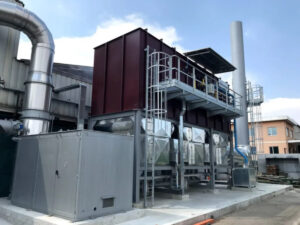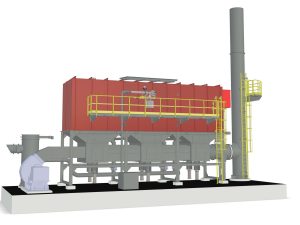Gıda kullanımı için esnek filmlerin basılmasındaki emisyonların arıtılması
In this field of application, the printing of flexible packaging destined to the food industry is achieved through rotogravure and flexographic printing presses. These machines use inks based on solvent mixtures which are hard to recover.
The environmental impact of flexible film printing processes
All printing processes that use solvent-based inks involve a drying phase during which the solvent found in the diluted inks is emitted into the atmosphere by the drying sections (ovens) of the printing machines.
Emissions characteristics
Air emissions from flexible film printing and coupling processes have the following characteristics:
| VARIABLE | CHARACTERISTICS |
|---|---|
| Temperature | 40-70°C, depending on the print support |
| Presence of volatile organic compounds (VOC) | Alcohols and esters (acetates) |
| Flow rates of emitted air | More or less high, depending on the number of printing and laminating machines and their characteristics |
| Operational cycle | On several daily shifts |
| Variability | High, depending on the machines operating simultaneously and on the amount of colors applied and the corresponding printing band |
Depuration goals
The main depuration goal is to minimize the emission of pollutants that damage the environment (V.O.C.) into the atmosphere, ensuring compliance with the regulatory limits for single pollutants and reusing the heat produced by the solvent oxidation in the production process.
The solution through the process of regenerative thermal oxidation
In order to solve the environmental issue and deal with highly variable emission flow rates and considerable solvent mass flows, a regenerative thermal oxidation plant combined with a heat recovery system for diathermic oil heating has been installed.
The diathermic oil heats the drying sections of the printing machines allowing to reuse the energy in the same production process that generated the polluting emission.
The measures identified for application in the flexible packaging industry
Regenerative thermal oxidation is frequently used to treat atmospheric emissions containing V.O.C. released during flexible packaging printing processes, when solvent recovery is not possible nor convenient due to the quantity and composition of the solvents used.
The application in the flexible packaging industry had to provide for the identification and application of specific measures aimed at enabling the following goals:
- The achievement of the highest purification performance, through a specific sizing of the process parameters.
- The optimization of energy consumption, thanks to the identification of an interesting form of energy recovery, to be used in the production process.
- The reduction of secondary pollutants produced by the oxidation process.
- The absence of interference with the production process, which requires the absolute absence of perturbations to the printing process.
The results achieved
The results obtained thanks to the combination of these technologies confirms the efficiency of the solution that has allowed us to achieve the following goals:
- The achievement of concentration values of pollutants emitted into the atmosphere significantly lower than the prescribed regulatory limits.
- Minimized energy consumption (the plant is basically always self-thermal, even with few printing presses sent to treatment) and exceeding heat reusability in the production process.
- Energy efficiency certificates.
- Extreme flexibility for customers to use inks with different solvent compositions.
- No interference with the production processes upstream of the purification plant.



